Consumer Behavior Analysis: Buying Decision Process and Models
VerifiedAdded on 2021/04/17
|5
|1118
|233
Homework Assignment
AI Summary
This assignment analyzes consumer behavior by examining the decision-making processes behind purchasing a mobile phone (iPhone), selecting a university (Charles Sturt University), and ordering from a restaurant (McDonald's). It breaks down each decision using the common buying decision process: problem recognition, information search, evaluation of alternatives, purchase decision, purchase, and post-purchase evaluation. The analysis considers factors influencing each choice, such as technical issues, budget, reputation, and convenience. The assignment also references the Marshallian model of consumer behavior, which posits that consumers aim to maximize satisfaction based on product quality and price. The provided references support the definitions and concepts discussed, offering a comprehensive overview of consumer behavior principles and their application in real-world scenarios.
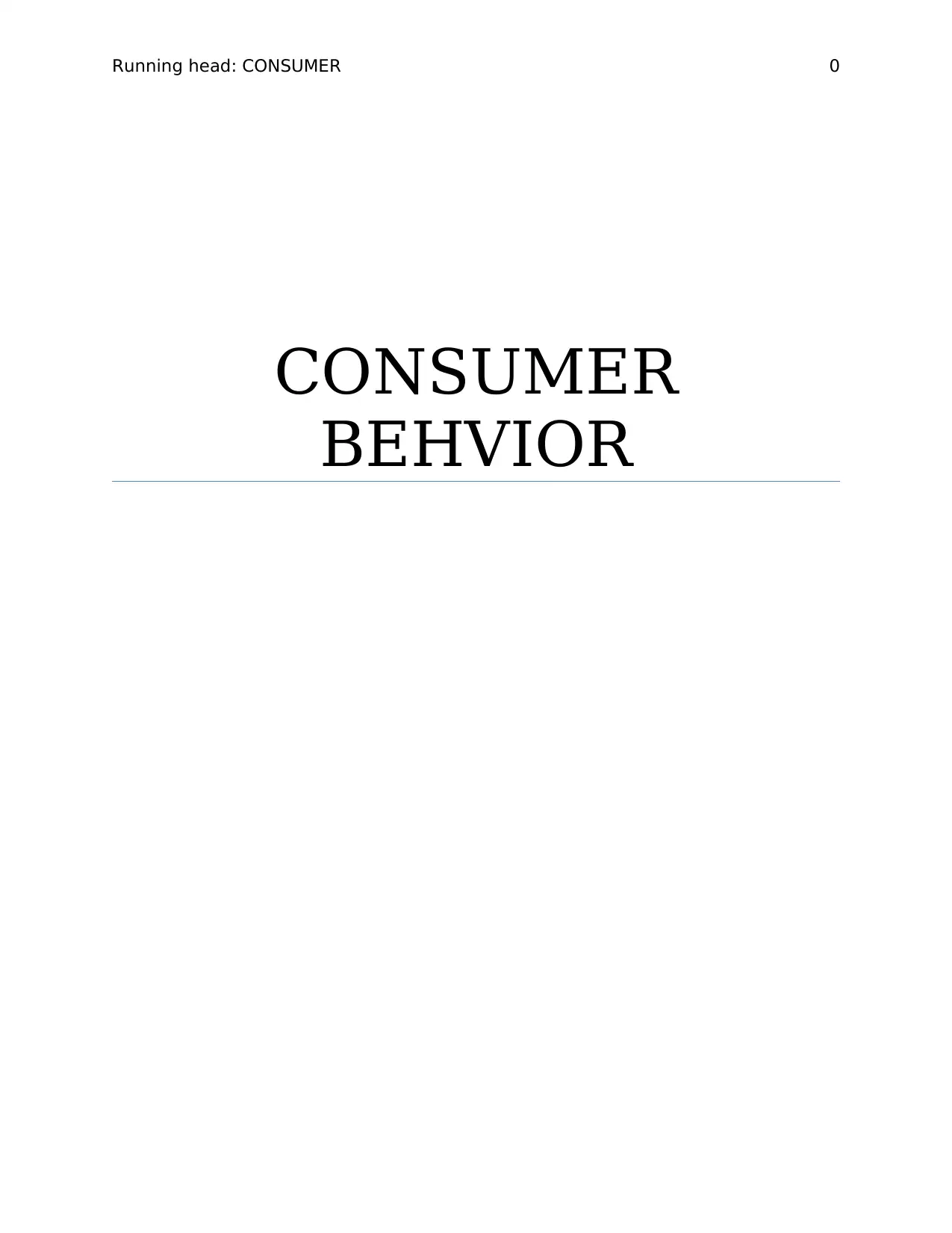
Running head: CONSUMER 0
CONSUMER
BEHVIOR
CONSUMER
BEHVIOR
Paraphrase This Document
Need a fresh take? Get an instant paraphrase of this document with our AI Paraphraser
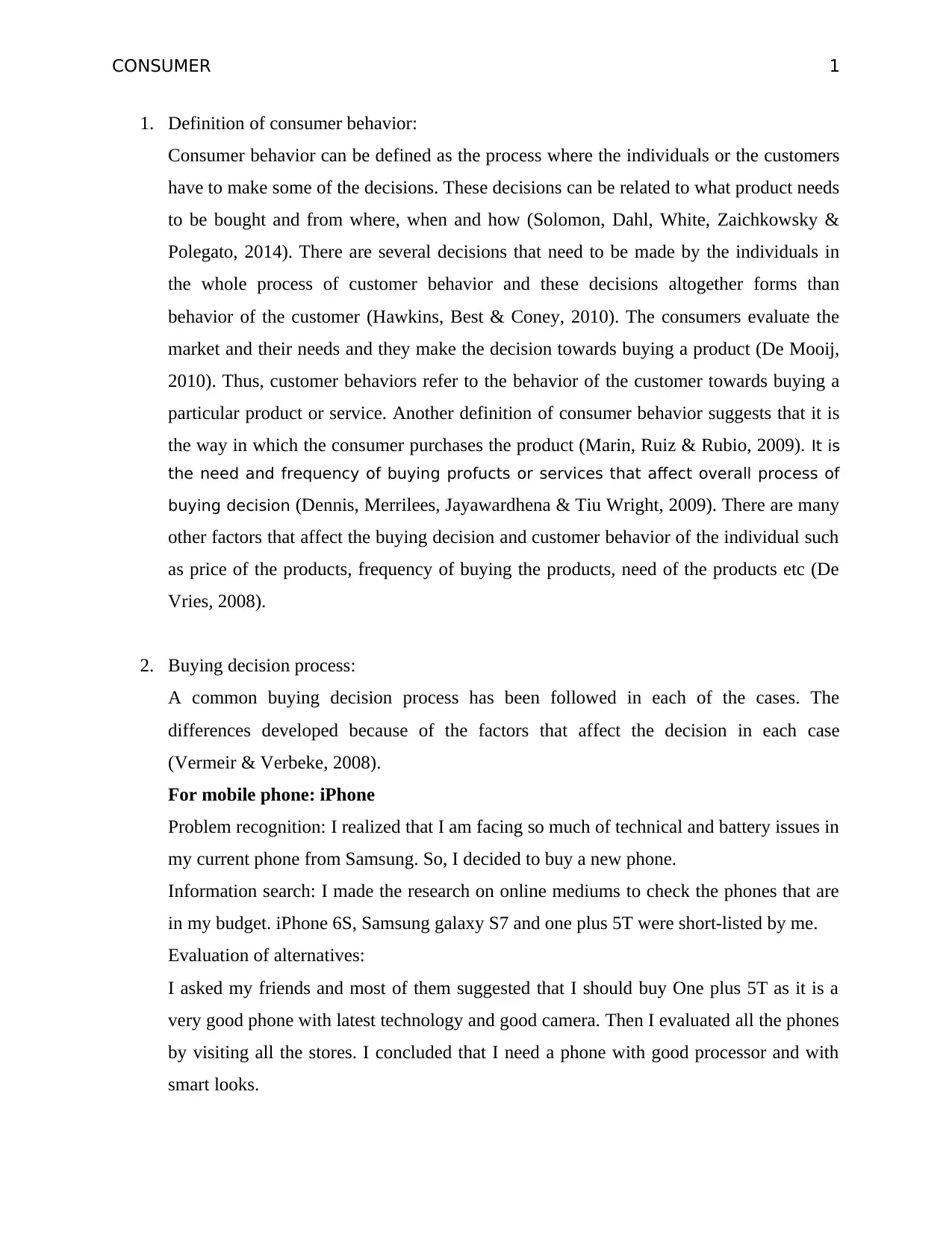
CONSUMER 1
1. Definition of consumer behavior:
Consumer behavior can be defined as the process where the individuals or the customers
have to make some of the decisions. These decisions can be related to what product needs
to be bought and from where, when and how (Solomon, Dahl, White, Zaichkowsky &
Polegato, 2014). There are several decisions that need to be made by the individuals in
the whole process of customer behavior and these decisions altogether forms than
behavior of the customer (Hawkins, Best & Coney, 2010). The consumers evaluate the
market and their needs and they make the decision towards buying a product (De Mooij,
2010). Thus, customer behaviors refer to the behavior of the customer towards buying a
particular product or service. Another definition of consumer behavior suggests that it is
the way in which the consumer purchases the product (Marin, Ruiz & Rubio, 2009). It is
the need and frequency of buying profucts or services that affect overall process of
buying decision (Dennis, Merrilees, Jayawardhena & Tiu Wright, 2009). There are many
other factors that affect the buying decision and customer behavior of the individual such
as price of the products, frequency of buying the products, need of the products etc (De
Vries, 2008).
2. Buying decision process:
A common buying decision process has been followed in each of the cases. The
differences developed because of the factors that affect the decision in each case
(Vermeir & Verbeke, 2008).
For mobile phone: iPhone
Problem recognition: I realized that I am facing so much of technical and battery issues in
my current phone from Samsung. So, I decided to buy a new phone.
Information search: I made the research on online mediums to check the phones that are
in my budget. iPhone 6S, Samsung galaxy S7 and one plus 5T were short-listed by me.
Evaluation of alternatives:
I asked my friends and most of them suggested that I should buy One plus 5T as it is a
very good phone with latest technology and good camera. Then I evaluated all the phones
by visiting all the stores. I concluded that I need a phone with good processor and with
smart looks.
1. Definition of consumer behavior:
Consumer behavior can be defined as the process where the individuals or the customers
have to make some of the decisions. These decisions can be related to what product needs
to be bought and from where, when and how (Solomon, Dahl, White, Zaichkowsky &
Polegato, 2014). There are several decisions that need to be made by the individuals in
the whole process of customer behavior and these decisions altogether forms than
behavior of the customer (Hawkins, Best & Coney, 2010). The consumers evaluate the
market and their needs and they make the decision towards buying a product (De Mooij,
2010). Thus, customer behaviors refer to the behavior of the customer towards buying a
particular product or service. Another definition of consumer behavior suggests that it is
the way in which the consumer purchases the product (Marin, Ruiz & Rubio, 2009). It is
the need and frequency of buying profucts or services that affect overall process of
buying decision (Dennis, Merrilees, Jayawardhena & Tiu Wright, 2009). There are many
other factors that affect the buying decision and customer behavior of the individual such
as price of the products, frequency of buying the products, need of the products etc (De
Vries, 2008).
2. Buying decision process:
A common buying decision process has been followed in each of the cases. The
differences developed because of the factors that affect the decision in each case
(Vermeir & Verbeke, 2008).
For mobile phone: iPhone
Problem recognition: I realized that I am facing so much of technical and battery issues in
my current phone from Samsung. So, I decided to buy a new phone.
Information search: I made the research on online mediums to check the phones that are
in my budget. iPhone 6S, Samsung galaxy S7 and one plus 5T were short-listed by me.
Evaluation of alternatives:
I asked my friends and most of them suggested that I should buy One plus 5T as it is a
very good phone with latest technology and good camera. Then I evaluated all the phones
by visiting all the stores. I concluded that I need a phone with good processor and with
smart looks.
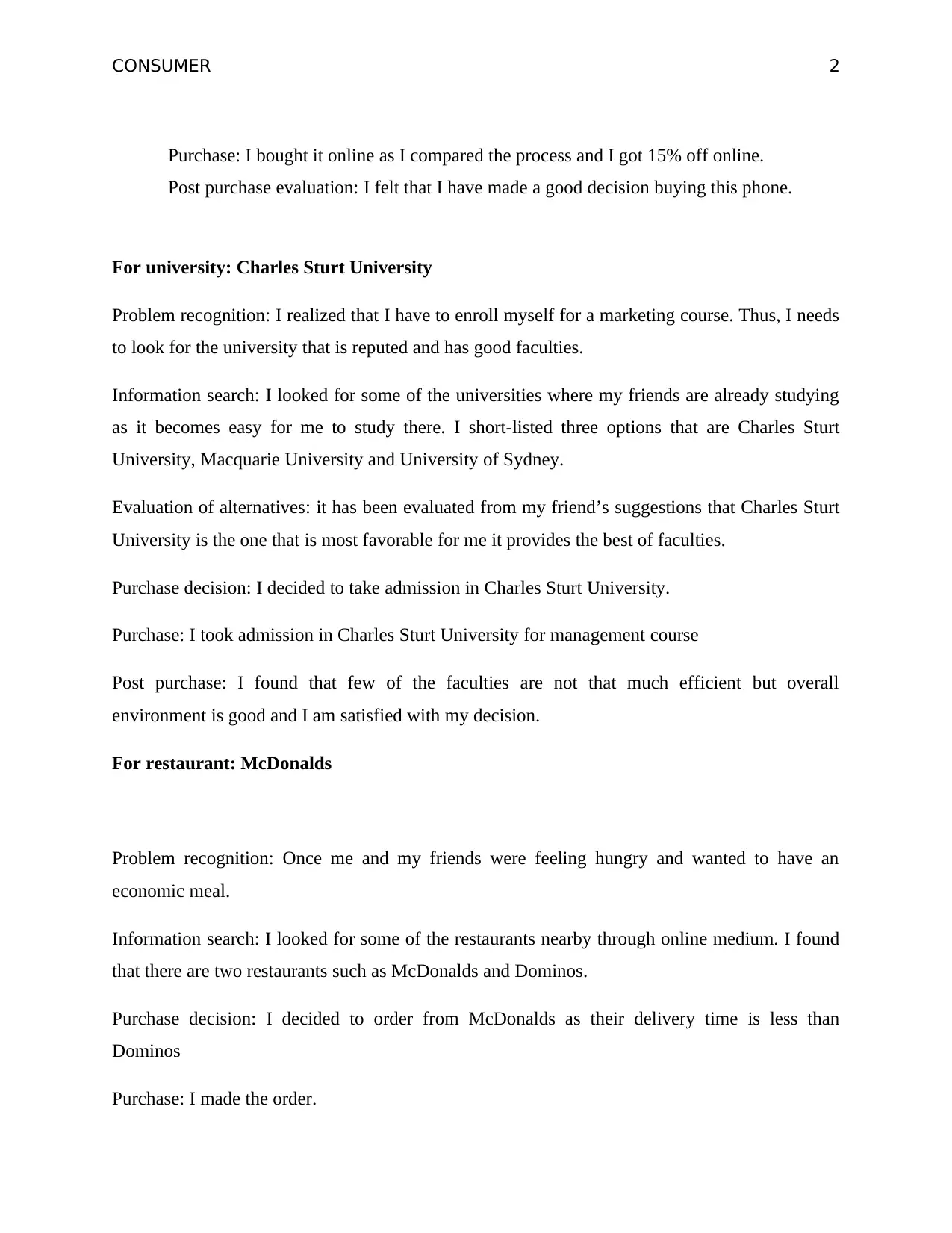
CONSUMER 2
Purchase: I bought it online as I compared the process and I got 15% off online.
Post purchase evaluation: I felt that I have made a good decision buying this phone.
For university: Charles Sturt University
Problem recognition: I realized that I have to enroll myself for a marketing course. Thus, I needs
to look for the university that is reputed and has good faculties.
Information search: I looked for some of the universities where my friends are already studying
as it becomes easy for me to study there. I short-listed three options that are Charles Sturt
University, Macquarie University and University of Sydney.
Evaluation of alternatives: it has been evaluated from my friend’s suggestions that Charles Sturt
University is the one that is most favorable for me it provides the best of faculties.
Purchase decision: I decided to take admission in Charles Sturt University.
Purchase: I took admission in Charles Sturt University for management course
Post purchase: I found that few of the faculties are not that much efficient but overall
environment is good and I am satisfied with my decision.
For restaurant: McDonalds
Problem recognition: Once me and my friends were feeling hungry and wanted to have an
economic meal.
Information search: I looked for some of the restaurants nearby through online medium. I found
that there are two restaurants such as McDonalds and Dominos.
Purchase decision: I decided to order from McDonalds as their delivery time is less than
Dominos
Purchase: I made the order.
Purchase: I bought it online as I compared the process and I got 15% off online.
Post purchase evaluation: I felt that I have made a good decision buying this phone.
For university: Charles Sturt University
Problem recognition: I realized that I have to enroll myself for a marketing course. Thus, I needs
to look for the university that is reputed and has good faculties.
Information search: I looked for some of the universities where my friends are already studying
as it becomes easy for me to study there. I short-listed three options that are Charles Sturt
University, Macquarie University and University of Sydney.
Evaluation of alternatives: it has been evaluated from my friend’s suggestions that Charles Sturt
University is the one that is most favorable for me it provides the best of faculties.
Purchase decision: I decided to take admission in Charles Sturt University.
Purchase: I took admission in Charles Sturt University for management course
Post purchase: I found that few of the faculties are not that much efficient but overall
environment is good and I am satisfied with my decision.
For restaurant: McDonalds
Problem recognition: Once me and my friends were feeling hungry and wanted to have an
economic meal.
Information search: I looked for some of the restaurants nearby through online medium. I found
that there are two restaurants such as McDonalds and Dominos.
Purchase decision: I decided to order from McDonalds as their delivery time is less than
Dominos
Purchase: I made the order.
⊘ This is a preview!⊘
Do you want full access?
Subscribe today to unlock all pages.

Trusted by 1+ million students worldwide
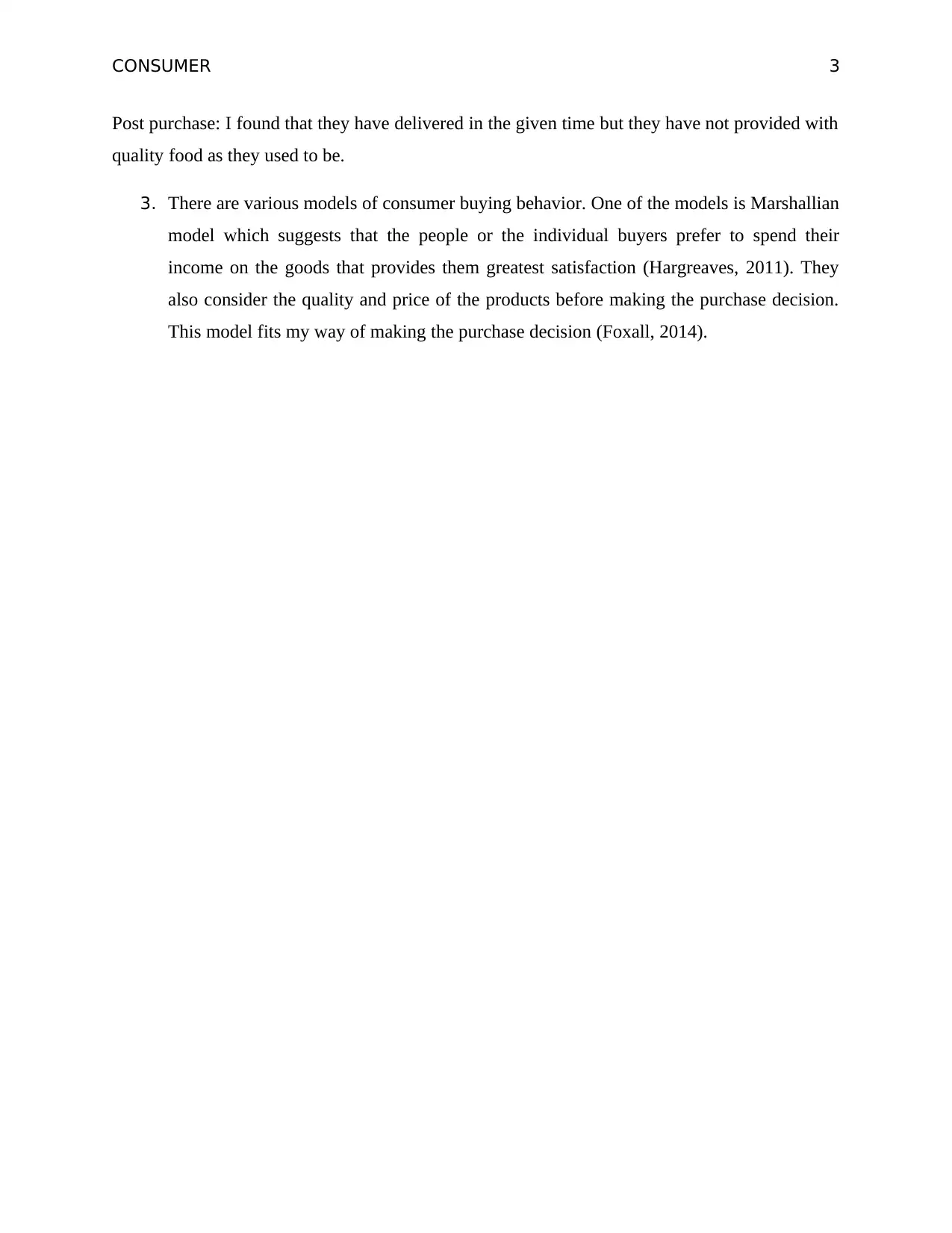
CONSUMER 3
Post purchase: I found that they have delivered in the given time but they have not provided with
quality food as they used to be.
3. There are various models of consumer buying behavior. One of the models is Marshallian
model which suggests that the people or the individual buyers prefer to spend their
income on the goods that provides them greatest satisfaction (Hargreaves, 2011). They
also consider the quality and price of the products before making the purchase decision.
This model fits my way of making the purchase decision (Foxall, 2014).
Post purchase: I found that they have delivered in the given time but they have not provided with
quality food as they used to be.
3. There are various models of consumer buying behavior. One of the models is Marshallian
model which suggests that the people or the individual buyers prefer to spend their
income on the goods that provides them greatest satisfaction (Hargreaves, 2011). They
also consider the quality and price of the products before making the purchase decision.
This model fits my way of making the purchase decision (Foxall, 2014).
Paraphrase This Document
Need a fresh take? Get an instant paraphrase of this document with our AI Paraphraser
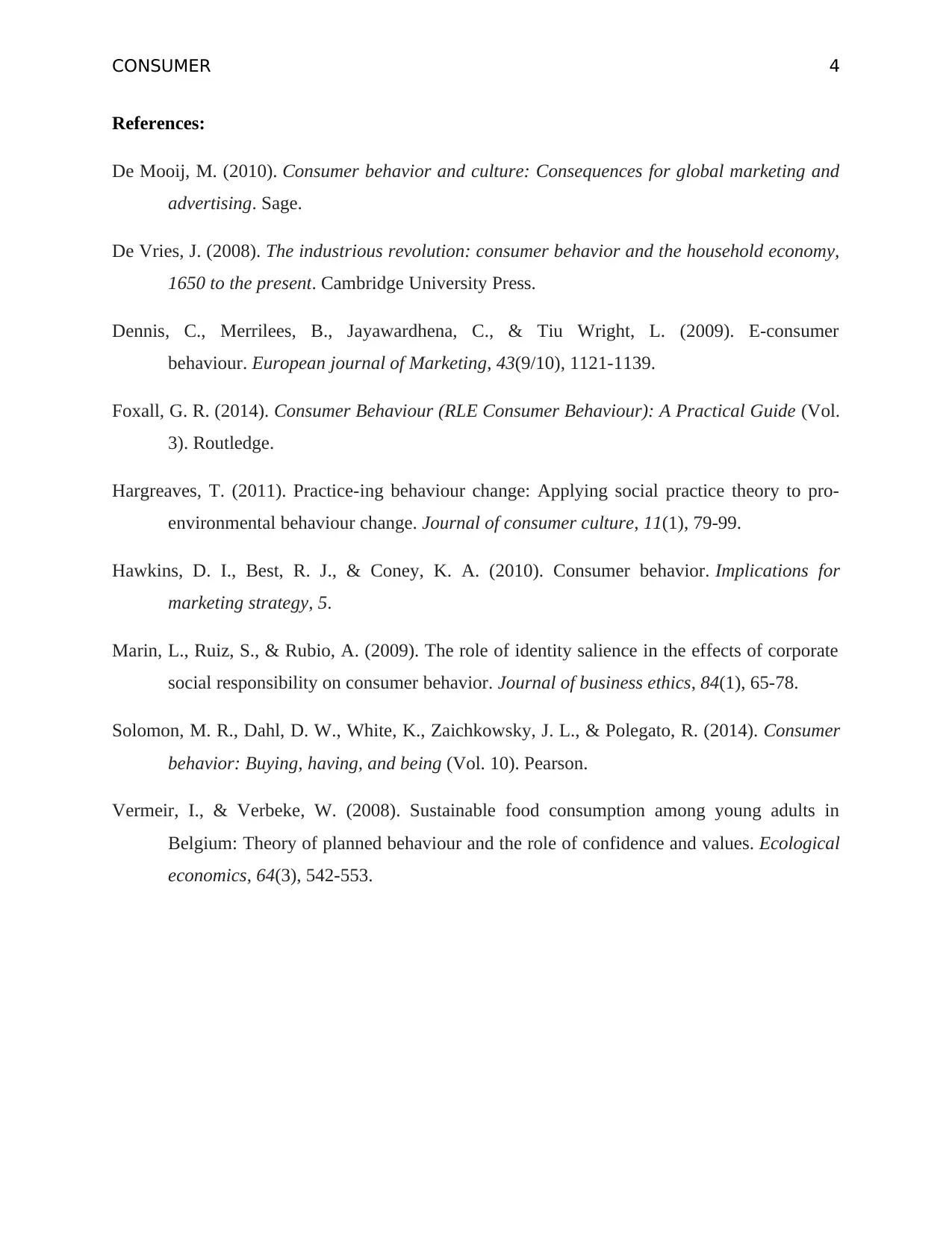
CONSUMER 4
References:
De Mooij, M. (2010). Consumer behavior and culture: Consequences for global marketing and
advertising. Sage.
De Vries, J. (2008). The industrious revolution: consumer behavior and the household economy,
1650 to the present. Cambridge University Press.
Dennis, C., Merrilees, B., Jayawardhena, C., & Tiu Wright, L. (2009). E-consumer
behaviour. European journal of Marketing, 43(9/10), 1121-1139.
Foxall, G. R. (2014). Consumer Behaviour (RLE Consumer Behaviour): A Practical Guide (Vol.
3). Routledge.
Hargreaves, T. (2011). Practice-ing behaviour change: Applying social practice theory to pro-
environmental behaviour change. Journal of consumer culture, 11(1), 79-99.
Hawkins, D. I., Best, R. J., & Coney, K. A. (2010). Consumer behavior. Implications for
marketing strategy, 5.
Marin, L., Ruiz, S., & Rubio, A. (2009). The role of identity salience in the effects of corporate
social responsibility on consumer behavior. Journal of business ethics, 84(1), 65-78.
Solomon, M. R., Dahl, D. W., White, K., Zaichkowsky, J. L., & Polegato, R. (2014). Consumer
behavior: Buying, having, and being (Vol. 10). Pearson.
Vermeir, I., & Verbeke, W. (2008). Sustainable food consumption among young adults in
Belgium: Theory of planned behaviour and the role of confidence and values. Ecological
economics, 64(3), 542-553.
References:
De Mooij, M. (2010). Consumer behavior and culture: Consequences for global marketing and
advertising. Sage.
De Vries, J. (2008). The industrious revolution: consumer behavior and the household economy,
1650 to the present. Cambridge University Press.
Dennis, C., Merrilees, B., Jayawardhena, C., & Tiu Wright, L. (2009). E-consumer
behaviour. European journal of Marketing, 43(9/10), 1121-1139.
Foxall, G. R. (2014). Consumer Behaviour (RLE Consumer Behaviour): A Practical Guide (Vol.
3). Routledge.
Hargreaves, T. (2011). Practice-ing behaviour change: Applying social practice theory to pro-
environmental behaviour change. Journal of consumer culture, 11(1), 79-99.
Hawkins, D. I., Best, R. J., & Coney, K. A. (2010). Consumer behavior. Implications for
marketing strategy, 5.
Marin, L., Ruiz, S., & Rubio, A. (2009). The role of identity salience in the effects of corporate
social responsibility on consumer behavior. Journal of business ethics, 84(1), 65-78.
Solomon, M. R., Dahl, D. W., White, K., Zaichkowsky, J. L., & Polegato, R. (2014). Consumer
behavior: Buying, having, and being (Vol. 10). Pearson.
Vermeir, I., & Verbeke, W. (2008). Sustainable food consumption among young adults in
Belgium: Theory of planned behaviour and the role of confidence and values. Ecological
economics, 64(3), 542-553.
1 out of 5
Related Documents
Your All-in-One AI-Powered Toolkit for Academic Success.
+13062052269
info@desklib.com
Available 24*7 on WhatsApp / Email
![[object Object]](/_next/static/media/star-bottom.7253800d.svg)
Unlock your academic potential
Copyright © 2020–2025 A2Z Services. All Rights Reserved. Developed and managed by ZUCOL.





